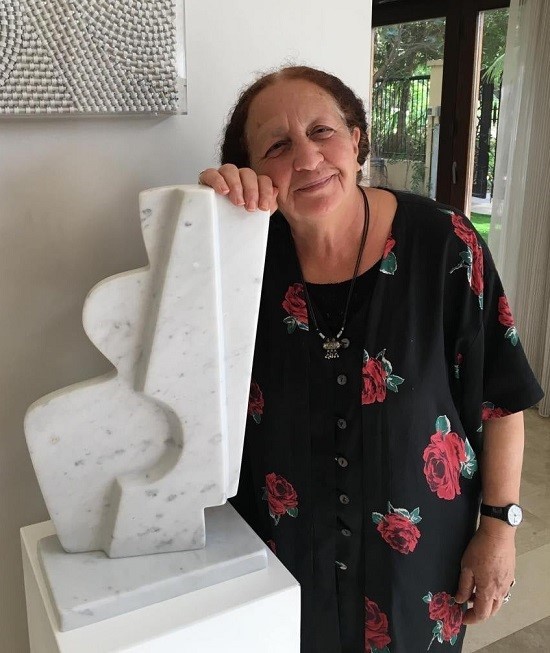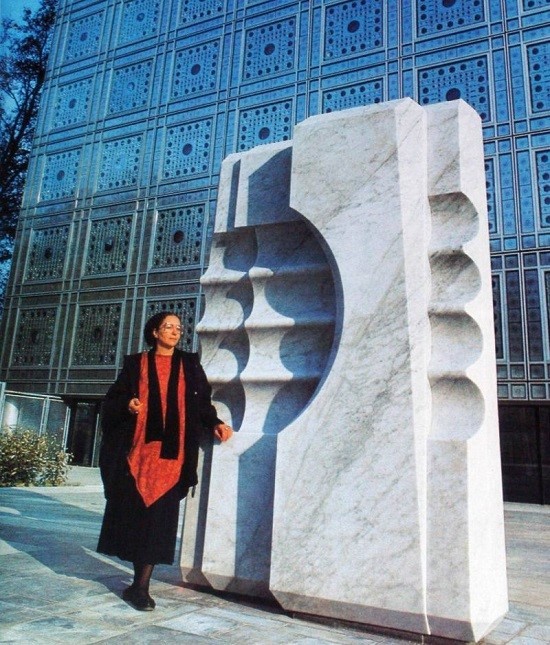Mona Saudi, a Jordanian sculptor whose works were celebrated
around the world, passed away on February 16 at the age of 76. Her daughter,
artist
Dia Batal, shared the news on Instagram, writing: “With the heaviest
heart, I share that my beautiful mama, sweetest grandmother and extraordinary
artist, Mona Saudi, has left us last night in her beloved city Beirut. Words
fail me beyond this.”
اضافة اعلان
Saudi, one of Jordan’s most acclaimed artists, was born in
Amman in 1945; she grew up close to the Roman Nymphaeum. Her sculptures, which
she once described as “geometric and organic at the same time”, were heavily
influenced by the ancient cultures of the Levant, and were often hewn from stone
native to the region – some of her most prominent works are chiseled from
blocks of Jordanian jade, marble, sandstone and limestone.
 (Photo: Facebook)
(Photo: Facebook)
“I took long walks through the bare hills of my then very
small town,
Amman, where our house was surrounded by ancient ruins dating back
many millennia, from the age of the Ammonites, the Edomites and the Nabataeans,
who were all stone carvers, and I felt and still feel that I belong to these
ancestors, and to my Mother Earth,” she said in 2010.
Saudi was a free spirit and a trailblazer who left home at
the age of 17, making her way to
Beirut to pursue her dream of becoming an
artist at a time when many in Jordan, including her own father, were against
the notion of women going to university or having jobs outside of being schoolteachers.
Her sculptures, which she once described as ‘geometric and organic at the same time’, were heavily influenced by the ancient cultures of the Levant, and were often hewn from stone native to the region
She arrived in Lebanon’s capital in the early 1970s, a time
when Beirut was at the cutting edge of modern Arabic art, culture and
progressive politics, and befriended poets like Mahmoud Darwish who would have
a huge influence on her drawings.
Saudi displayed her early drawings at the Café de la Presse
in Beirut’s old An-Nahar newspaper building, and used the money she made
selling them to pay her tuition at the École Nationale Superieure des
Beaux-Arts in Paris. She returned to Beirut after graduating, and remained a
fixture in the city during and after the Lebanese Civil War.
Saudi also stayed connected to her home country, Jordan,
holding a solo exhibition at the Balkaa Art Gallery in
Fuheis in 1992 and
displaying her first major retrospective at Darat Al Funun in Amman in 1995.
Her art has been displayed around the world – her huge marble sculpture
Géométrie de l’esprit is installed outside the
Institut du Monde Arabe in
Paris, and several of her works owned by the British Museum will be on view in
an upcoming exhibition titled “Feminine Power”.
 (Photo: Facebook)
(Photo: Facebook)
Her art can also be found in collections around the world,
including the Sharjah Art Foundation, the
National Museum of Women in the Arts in Washington, DC and the Ministry of Culture in Cairo.
Some of Saudi’s notable works include Mother/Earth from
1969, In Time of War: Children Testify from 1970, Growth, a Jordanian jade
piece from 2002, and The Seed from 2007.
Saudi’s lifelong drive to create resulted in a striking
collection of sculptures, often massive in stature, unique and consistently
modern across decades of artistic output, and cohesively unified in their
melding of motifs drawn from the geometries of ancient eastern cultures with
the organic curves of the natural world.
 (Photo: Facebook)
(Photo: Facebook)
In explaining the “serene and balanced” aesthetic which runs
through all of her varied works, she once said: “I do not like expressive art,
and I do not like violence in life or in art. I like beauty and harmony and
always want to feel the divinity of our existence and of the trees, birds and
other creatures around us. There is already so much violence in our lives, so
why repeat it in art. For me art is a moment of contemplation, of inner peace.”
Read more Culture and Arts



